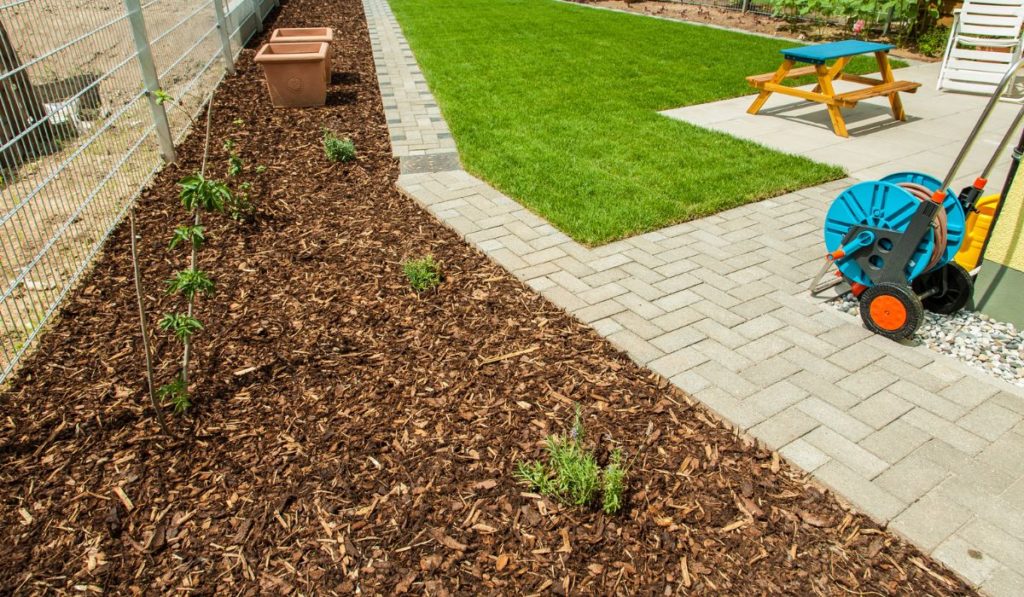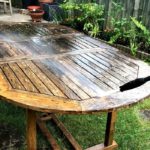Mulch preserves moisture, replenishes soil nutrients, regulates soil temperature, and prevents weed growth. But a common mulch problem emerges during heavy storms when flood water washes away organic mulching materials. The rain tends to move mulch to the sidewalks or driveway, leaving your garden exposed. Learning how to keep mulch in place is an easy way to protect your plants throughout the year.
To prevent mulch from washing away, choose heavy and coarse materials that compact easily. Other ways to keep mulch in place include edging the garden, reducing the slope, and removing the mulch under layer. Using low-ground cover plants to help to help, and manage drainage that’s eroding the area.
There are different methods to prevent mulch from washing away and exposing your plants. The solutions range from changing the choice of mulch and creating mulch barriers to regrading your landscape. Let’s find out why mulch washes away and take a look at some ways to prevent it from happening on your property.
Why Does Mulch Wash Away?

Organic mulch washes away for several reasons, including:
Weight/ Texture of the Mulch
Lightweight mulch materials can easily wash away following heavy storms or flooding if they’re not properly installed. Such materials don’t bond quickly and the water easily pushes the mulch layer away from your garden.
The finer the texture of the mulch, the more likely it is to wash away.
Depth of the Mulch
If you have a raised mulch bed, the risk of the organic materials washing away is high. The raised layer of organic materials has no support on the edges. When it rains, the exposed mulch layer joins the flow of the water.
Sloping Gradient
A sloping gradient is another reason mulch easily washes away. If you have a sloping garden, you might struggle to maintain your mulch bed in the wet season. If you don’t reduce the slope, the mulch layer flows down the landscape when it rains.
Plastic Weed Barrier
Many garden owners install plastic under mulch to prevent weed growth. The idea is to smother weeds and also deny seeds the light required for germination.
While the technique is common in landscaping, the plastic sheeting can cause problems when it rains. In heavy rain, surface water flows quickly on the plastic underlayer and washes away the mulch.
How to Keep Mulch From Moving
Installing organic mulch takes a lot of time and effort. The mulch layer is critical to a healthy garden, but you’ve got to learn how to keep it in place during heavy rains.
When mulch washes away, it creates a mess on your property, and then you’ve got to spend more time raking back the materials to the planting bed.
Here are some solutions to prevent mulch from washing away during heavy rains:
Select Heavier/ Coarse Mulch
Lightweight and loose-textured mulch made of bark nuggets or wood chips is a popular choice, but it floats on water and washes away quickly. Consider heavier and coarser alternative mulches for your garden including:
- Pine straw/needles (on Amazon)
- Shredded hardwood mulch (on Amazon)
- Pea gravel (on Amazon)
- Rubber mulch (on Amazon)
Edge Your Mulch Beds
Edging is a simple yet effective landscaping technique that protects your plants by keeping mulch inside the garden. Edging prevents mulch erosion and helps maintain a neat look to your landscape. During floods, the perimeter edge prevents organic mulch from washing away into the flower beds or other landscaping features.
Effective edging options for your planting include:
- Perimeter plants: Short border plants not only keep mulch in its place during heavy rains but also add an aesthetic touch to your landscape.
- Physical edging material: You can erect permanent edging materials such as metal, stone, wood, plastic, pavers, or concrete to create a barrier around your planting bed.
- Trenching: If you have a big problem with mulch washing away, a 3- or 4-inch trench around the garden can help. The trench traps the mulch before it messes up the rest of the landscape.
Reduce the Slope Gradient
If you have a sloping landscape, the mulch on your gardens will easily wash away when it rains. You can reduce or eliminate the gradient by erecting a raised garden bed on the slope, or through terracing. The raised garden bed prevents mulch erosion while maintaining the aesthetics of your garden.
Plant Low-Growing Plants
To anchor mulch on your garden, consider low-growing cover plants. The plants help keep the garden mulch in place even when it rains. These plants protect the mulch and create an elegant look for your garden.
Solve Drainage Problems
If the mulch on your garden washes away every time it rains, you could have a drainage problem in your garden. Poor drainage increases the risk of flooding in your garden.
Improving drainage on your property is an effective way to prevent mulch from washing away. Check the gutters and downspouts and confirm whether the water from the roof drains away from your garden. Using a downspout extension (on Amazon) helps redirects water away from your garden and protects the mulch layer.
Other drainage solutions include laying a trench tile or pipes around the edge of your garden. An efficient drainage system on your landscape protects your property and ensures mulch stays in place.
Remove the Mulch Underlayer
A plastic sheeting underlayer on your garden makes it easier for mulch to slide away during heavy rains. The sheeting blocks water from seeping through to the soil beneath and increases the risk of mulch floating into the flower beds.
Removing the landscaping plastic is one way to prevent mulch from washing away. Using multiple layers of thin mulch serves the same purpose as the plastic and suppresses weed growth.
How to Place Mulch So It Won’t Wash Away
Proper mulch installation makes all the difference in preventing problems when it rains. If you want a healthy garden, you should familiarize yourself with how to place mulch properly. Even with the best kind of mulch, you might have a problem when it rains if you don’t install it properly.
Below is a step-by-step guide to place mulch so that it doesn’t wash away:
- Remove weeds: Start by removing any weeds physically, using herbicide, or by cutting them close to the ground.
- Edge your garden: Edging the garden is an effective way to provide a stable foundation for your mulch layer. The barrier you choose separates the garden bed from other parts of your landscape.
- Prepare the mulch bed: Remove any old mulch, plastic or cloth sheeting, and any other debris on the mulch bed.
- Place the mulch in thin layers: Lay your mulch in thin layers with a shovel. Rake the mulch layer to create flat ground and add the next layer. The mulch layer thickness should range from 2 to 3 inches in order to provide sufficient protection against weeds.
- Water organic mulch: If you’ve placed organic mulch on your garden, water the bed to help the materials mat together. The wet matter doesn’t blow away as easily.
Tips for Maintaining Mulch

Well-maintained mulch lasts longer and offers more benefits to your garden. Here are simple ways to maintain your mulch for a healthy garden:
- Remove weeds regularly
- Refresh the mulch color with a thin layer of fresh mulch
- Mix and turn mulch to break off clustered pieces or compacted layers
- Refresh the mulch at least twice a year
- Edge your garden or use other techniques to prevent the mulch from washing away








